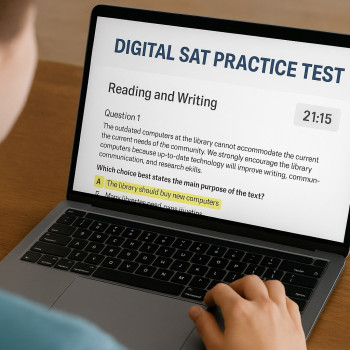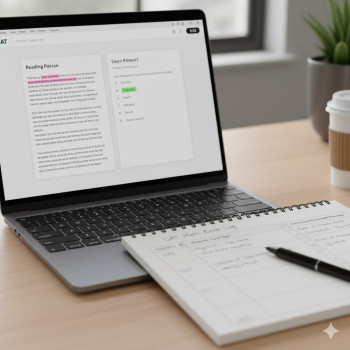Why syncing matters for the Digital SAT (and your sanity)
Studying for the Digital SAT is different from studying for a paper test. Your practice lives on apps, in browser tabs, and in PDF downloads. You’ll switch between your phone, tablet, and laptop dozens of times a week — during class breaks, on the bus, and in weekend study marathons. If those moments don’t add up into a coherent plan, your progress stalls and frustration grows.
Syncing your study ecosystem means more than just putting the same files on three devices. It’s about creating a workflow that automatically remembers where you left off, helps you review the right things at the right time, and gives you the flexibility to practice under realistic testing conditions. Done well, this approach turns scattered sessions into steady progress.
Start with the right mindset: consistency over perfection
This is the one-size-fits-most principle that most students miss. You don’t need a perfect set of apps or the latest tablet. You need routines that fit your life. The goal is to reduce friction — the tiny choices that interrupt momentum, like hunting for a file or transferring notes between devices.
Begin by answering two quick questions honestly:
- Which device do I actually use most for focused study? (Be honest: phone scrolling doesn’t count.)
- When and where do I have 10–30 uninterrupted minutes each day?
Your answers determine how you design your sync system. If you study deeply on a laptop but review flashcards on your phone during transit, prioritize file sync on the laptop and lightweight review tools on the phone.
Essential tools for cross‑device SAT study
Here are categories of tools you’ll want — and simple, device‑friendly examples. You don’t need all of them; pick what fits your routine.
- Cloud storage: Keeps full-length practice tests, score reports, and problem sets available across devices.
- Note app with sync: Your main repository for strategies, error logs, and worked problems.
- Flashcard app: Spaced repetition for vocab, grammar rules, and math facts.
- Browser bookmarks or reading list: For articles, strategy posts, and College Board guidance you want to return to.
- Practice test app: Official practice via downloadable tests — make sure you can access the same practice on each device where possible.
- Timer / focus tool: For Pomodoro sessions and realistic timed practice.
Practical pairings by device role
Think of each device as playing a role, not a hierarchy. Below are common role setups so you can match tools to them.
- Phone — quick review & flashcards: Short, focused sessions; use a flashcard app and a lightweight notes widget.
- Tablet — guided practice & annotations: Ideal for digital reading passages and handwriting math work when paired with a stylus.
- Laptop — heavy lifting & full practice tests: Long practice tests, in‑depth review, and writing longer strategy notes.
Step‑by‑step setup: sync your devices the smart way
Follow these steps to build a friction-free study ecosystem. Each step includes short, concrete actions you can take in less than 30 minutes.
1. Centralize your master materials
Pick one cloud storage space that becomes the single source of truth for full-length tests, downloaded Bluebook practice files, and your master error log.
- Create three folders: “Practice Tests,” “My Mistakes & Notes,” and “Timed Drills.”
- Upload your most recent practice test to the “Practice Tests” folder and keep the score report next to it.
2. Choose a note app and make it your study brain
Use a note app that syncs instantly across devices and supports searching, tagging, and quick linking between notes. That’s where you’ll keep your error log, strategy templates (for reading, writing, and math), and daily study checklist.
- Set up a template note for reviewing a practice test: date, total time, score, top 3 mistakes, 5 takeaways, and an action plan for the next session.
- Tag every practice review with subjects like “Reading,” “Writing,” and “Heart‑math” so you can pull up trends fast.
3. Make flashcards portable and purposeful
Put vocabulary, grammar rules, and math formulas into a spaced repetition app. Review a small, fixed number of cards daily so phone sessions remain short and powerful.
- Limit new cards to 10 per week — bite-sized additions mean you can realistically review them on the phone.
- Group cards by skill (e.g., “Sentence Structure,” “Function Rules”) to create focused review blocks.
4. Sync practice progress, not just files
When you switch devices, what matters is where you were working and what’s next. Use one of these simple conventions:
- Update a single “Today” note every session with the last problem number you completed and the next 30‑minute goal.
- Use calendar blocks labeled “SAT: Reading Passage 7” or “SAT: Math Drill 20” so your phone reminders bring you back to the exact task.
5. Rehearse test conditions on each device
Your goal is to be comfortable with both the testing app and the device you’ll actually use on test day. Practice a timed section on your laptop, then replicate the same timed section on a tablet — if you’ll switch devices for practice, don’t be surprised by interface differences on test day.
Study templates and schedules that sync well
Here are two realistic weekly templates that scale to your time. Both assume you’re using phone, tablet, and laptop in complementary ways.
Template A — 5‑hour weekly plan (busy student)
- Mon (30 min phone): Quick flashcards + 1 grammar micro‑lesson.
- Wed (60 min tablet): Timed Reading section with annotation; quick notes into your review app.
- Fri (30 min phone): Vocabulary review + error flashcard creation.
- Sat (3 hours laptop): Full diagnostic practice test every 2 weeks or 90 minutes of mixed section drills weekly; full review afterward.
Template B — 10‑hour weekly plan (targeted prep)
- Mon (60 min tablet): Focused Math drill (timed problem sets).
- Tue (45 min phone): Flashcards + 20 min warm‑up of problem types you missed.
- Thu (60 min laptop): Writing & language practice with deep review and rewrites in your notes app.
- Sat (4–5 hours laptop/tablet): Full practice test + 60–90 minute review session logged in your master note.
- Sun (60 min phone/tablet): Light review, reflection, and planning for the coming week.
How to handle downloads, Bluebook, and test simulation
For Digital SAT prep, practice on the same platforms you’ll use for the test. Download Bluebook practice tests to the device you plan to test on and run at least three full-length simulations on that same device. This reduces surprises and builds muscle memory for navigation, timing, and the on‑screen tools.
| Item | Laptop | Tablet | Phone |
|---|---|---|---|
| Best use | Full practice tests & detailed review | Timed sections & annotation practice | Flashcards & quick warmups |
| Must‑have app | Bluebook / browser practice / notes | Bluebook / stylus-enabled note app | Flashcard app / quick notes |
| When to use | Long blocks (60+ minutes) | 30–60 minute focused practice | 5–20 minute micro sessions |
Run Bluebook downloads on the device you intend to use well before test day. Confirm device readiness (battery health, allowed updates disabled, and local downloads completed) so the app behaves predictably.
Smart review: turn mistakes into a synced advantage
Most students review practice tests passively. Instead, build an error log that syncs across devices and becomes the engine of your study plan.
- After each test, create an “Error Card” in your notes app: problem, error type, why you made it, how to avoid it, and a mini practice set of 3 similar problems.
- Tag these error cards by skill and set one daily phone review of 3 error cards so short sessions stay high value.
- Use the tablet or laptop to actively rework the problems (rewrite the solution) and save the reworked steps as images or annotated PDFs in your cloud folder.
Reducing friction: automation and small hacks
Automate the boring stuff so you can study more efficiently:
- Use a synced calendar (with alarms on your phone) to remind you of daily study blocks and test simulations.
- Create templates for practice test reviews to reduce the mental load of getting started.
- Voice memos: after a tough problem, record a 30‑second explanation on your phone and drop it into the note. Later, listening to your own explanation strengthens recall.
When sync breaks: a quick troubleshooting checklist
Syncing problems are inevitable. Here’s a short checklist to fix the most common issues fast:
- Is Wi‑Fi on? Some apps require connectivity to sync. Try toggling Wi‑Fi or reconnecting.
- Is storage full? Cloud sync can stall if one device is out of space.
- Are app versions mismatched? Update your note app and flashcard app across devices.
- Has the file been renamed or moved? Keep one consistent folder structure in the cloud so links don’t break.
Designing realistic practice sessions across devices
Practice that mirrors test conditions builds confidence. That means timed sections, quiet environment, and the device you’ll use on test day. If you can’t always practice on that same device, simulate the experience:
- Run a timed Reading section on the tablet with a stylus, mark passages, and mirror the Bluebook interface where possible.
- Use your laptop for full tests and the tablet for focused passages — then compare pacing and error types between sessions to identify where device differences matter.
Leveraging personalized help when you need it
Self‑directed study is powerful, but targeted guidance accelerates improvement. If you find that certain error patterns repeat — like consistent algebra mistakes or timing breakdowns in Reading — a short series of tailored sessions can be transformative.
Sparkl’s personalized tutoring offers 1‑on‑1 guidance, tailored study plans, expert tutors, and AI‑driven insights that can plug directly into your synced study workflow. A tutor can review your synced error log, help you design tablet‑specific annotation strategies, and set device‑based drills that match your real test conditions.
Examples: three student scenarios and workflows
Below are realistic examples to show how syncing decisions play out in life.
Case 1: Maya — the commuter
Maya studies on a crowded bus. Her phone is her primary review tool; she uses a tablet at home for heavy practice and a laptop at school for tests. Her setup:
- Phone: flashcard app and a “Review Today” note widget.
- Tablet: stylus notes, timed Reading passages saved to the cloud.
- Laptop: full practice tests with exported score reports saved to the master folder.
Every night Maya updates the “Review Today” note with three error cards pulled from the laptop review. On the bus the next morning she flips through those three cards — high signal, low time cost.
Case 2: Jonah — the deep‑dive weekend studier
Jonah has big weekend blocks. He runs two full tests on his laptop every other weekend and uses his tablet during the week for targeted sections. He keeps a long form error log in his note app and records voice explanations for tricky problems on his phone. The voice notes become quick practice on short weekday breaks.
Case 3: Priya — juggling school and activities
Priya uses short daily phone sessions for vocab, the tablet for math practice after practice, and the laptop for weekly tests. Her calendar blocks auto‑populate from her study template so she doesn’t have to recreate plans each week.
Measuring progress across devices: simple metrics that matter
Don’t chase perfect scores; track the small, leading indicators that predict improvement.
- Percent of timed sections completed on your primary test device each week.
- Number of unique error types reduced month over month.
- Average time per math grid‑in question under timed conditions.
Keep these metrics in a single “Progress” note that syncs across devices. Review them weekly and adjust your device usage if you see patterns (for example, consistent slower pacing on the tablet might mean you need more tablet-based timed practice).
Wrapping up: make sync your study superpower
When your phone, tablet, and laptop work together, every 10‑minute burst becomes meaningful. The synergy you build — one synced error log, one master folder, and a few honest routines — converts scattered energy into steady growth. You’ll spend less time remembering what to do and more time actually improving.
And when you feel stuck, targeted support — such as personalized tutoring with Sparkl’s 1‑on‑1 sessions and tailored study plans — can help close gaps faster. The right coach can look at your synced data, suggest device‑specific drills, and keep you accountable in a way that complements your tech setup.
Start small: pick one sync habit to add this week — maybe a single “Today” note or a three‑card flash review on your phone — and build from there. Over a few weeks, those tiny habits compound into real scores, deeper understanding, and more confident test day performance.
Good luck — and remember, effective SAT prep is less about hours logged and more about the systems that make each minute count. Sync your study, practice deliberately, and don’t be afraid to ask for targeted help when you need it. You’ve got this.















No Comments
Leave a comment Cancel